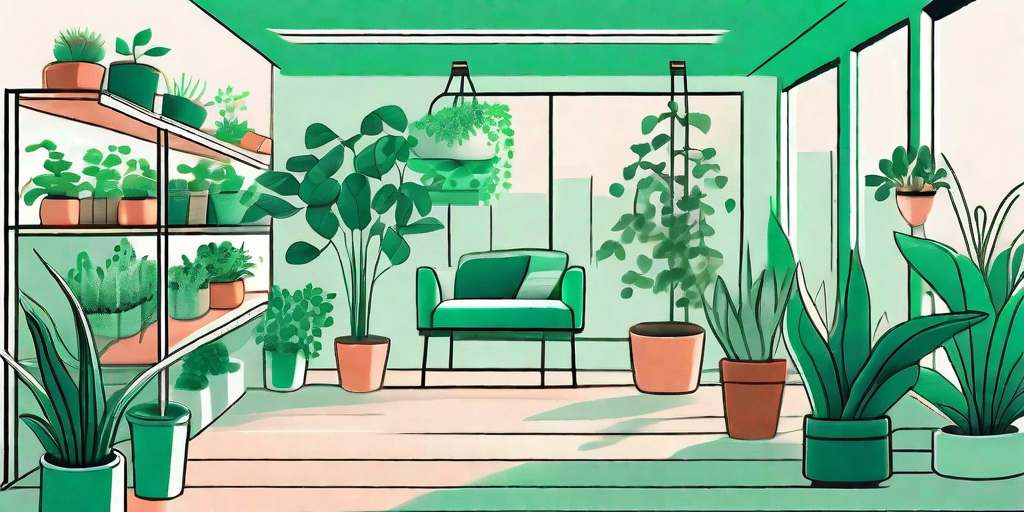
If you've been staring at the same four walls during quarantine and are yearning for a change, why not add a touch of green to your home? Indoor plants not only add aesthetic appeal, but they also improve air quality and can even boost your mood. So, let's get down to the nitty-gritty of greening up your quarantine.
Choosing the Right Plants
Before you run off to the nearest nursery or start browsing online plant shops, it's important to know which plants are best suited for indoor living. Not all plants are created equal, and some are more high-maintenance than others. We wouldn't want you to become a plant serial killer, now would we?
Consider factors like light, temperature, humidity, and your own ability to care for the plants. If you're a newbie, you might want to start with something hardy and forgiving, like a snake plant or a ZZ plant. These plants are like the introverts of the plant world - they don't need much attention and they're okay with being left alone.
Light Requirements
Plants are like people - some of them love the sun, while others prefer the shade. It's important to match the light requirements of the plant to the conditions in your home. For instance, succulents and cacti love bright, direct light, while ferns and ivies are happy in low light conditions.
Don't have much natural light in your home? Don't despair! There are plenty of low-light loving plants out there. Plus, you can always supplement with artificial light. Just remember, plants can't survive on Netflix binges alone.
Temperature and Humidity
Most indoor plants prefer temperatures between 60 and 75 degrees Fahrenheit, which is typically the temperature range in most homes. However, some plants, like orchids and ferns, prefer higher humidity levels. If you live in a dry climate or have a home with dry air, these might not be the best choice for you.
On the other hand, if your home is more like a tropical rainforest, these plants will feel right at home. Just remember to keep them away from drafts and heating vents, as sudden temperature changes can shock them. And nobody likes a shocked plant.
Plant Care 101
Once you've chosen your new green friends, it's time to learn how to take care of them. Contrary to popular belief, plant care doesn't have to be complicated. In fact, most plants are pretty low-maintenance. They just need the right amount of light, water, and love.
Overwatering is the number one killer of indoor plants. So, if you're the type of person who shows love by giving too much, you might want to hold back a bit. Most plants prefer to dry out a bit between waterings. When in doubt, stick your finger in the soil. If it's dry up to your first knuckle, it's time to water.
Feeding Your Plants
Plants need food too! But don't worry, they're not picky eaters. A general-purpose houseplant fertilizer will do the trick. Just remember to follow the package instructions. Over-fertilizing can be just as harmful as overwatering.
Most indoor plants go dormant in the winter, so they don't need to be fed during this time. Come spring, start feeding them again to support new growth. Just like us, they need a little extra nourishment after a long winter's nap.
Pruning and Repotting
Pruning isn't just for outdoor plants. Indoor plants can benefit from a little trim now and then too. It helps to keep them healthy and looking their best. Plus, it's a great way to keep them from taking over your living room.
Repotting is another important aspect of plant care. As plants grow, they can become root-bound, which means their roots have filled up the pot and they have no room to grow. If your plant is wilting, yellowing, or its roots are growing out of the drainage holes, it might be time for a bigger pot.
FAQs
- What are some easy-to-care-for indoor plants?
- Snake plants, ZZ plants, pothos, and spider plants are all great choices for beginners.
- How often should I water my indoor plants?
- This depends on the type of plant, but most prefer to dry out a bit between waterings. When in doubt, stick your finger in the soil. If it's dry up to your first knuckle, it's time to water.
- Do indoor plants need fertilizer?
- Yes, indoor plants need to be fed. A general-purpose houseplant fertilizer will do the trick. Just remember to follow the package instructions and only feed during the growing season (spring and summer).
Conclusion
Adding plants to your home can be a fun and rewarding experience. Not only do they add a touch of green to your space, but they also improve air quality and can even boost your mood. So, what are you waiting for? It's time to green up your quarantine!
And remember, plants are like pets. They need care and attention, but they also give back in spades. So, treat them well and they'll reward you with lush, green growth and maybe even a flower or two. Happy planting!















